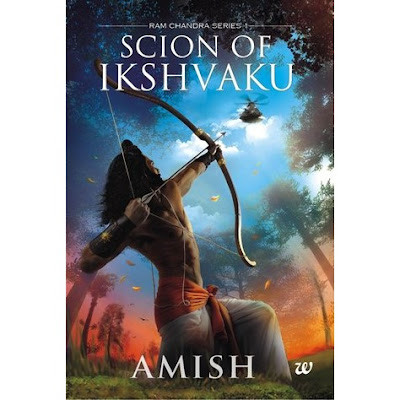An insight to Scion of Ikshvaku : 1st part of the retelling of Ramayana
Yet again another myth-historical master piece has escaped from the pen of India’s Tolkien. After the well scribed Shiva trilogy now Amish Tripathy presents to us the story of Ramchandra the great legendary emperor of Ayodhya. The story is based on one of the two great epics of the ancient/Vedic India. Yet again the unique ingredient is the amalgamation of fiction, Myth and history. The ideologies of masculine and feminine society and their pros and cons are being presented with clarity.
 The story is clearly based on the Great
Vedic Epic ‘Ramayana’. Amish had refined the story with realistic historical
& scientific data. But as expected the basic story is all but same. Ayodhya
has been portrayed as “a civilisation in an advanced state of decay”. It is weakened by divisions and corruption.
To worsen the condition the defeat of Dasaratha, the emperor of Ayodhya to
Ravana caused a steady decline in the empire’s economy. This 1st
instalment of this grand series showcases how Ram, an idealist prince tries to
lead the people of Sapt Sindhu out of the morass.
The story is clearly based on the Great
Vedic Epic ‘Ramayana’. Amish had refined the story with realistic historical
& scientific data. But as expected the basic story is all but same. Ayodhya
has been portrayed as “a civilisation in an advanced state of decay”. It is weakened by divisions and corruption.
To worsen the condition the defeat of Dasaratha, the emperor of Ayodhya to
Ravana caused a steady decline in the empire’s economy. This 1st
instalment of this grand series showcases how Ram, an idealist prince tries to
lead the people of Sapt Sindhu out of the morass.
The story gets more interesting due to the
presentation of various ideologies and interpretations.
“We
are a civilisation in an advanced state of decay. We’re the most hypocritical
people on earth. We criticise corruption in others, but are blind to our own
dishonesty. We hate others who do wrong and commit crimes, blithely ignoring
our own misdeeds, big and small.”
These words of Bharat during a conversation
with his brothers are quite captivating and can be related to our modern
society where corruption has a healthy position. The vivid images of the places and their
ideals make us a part of the civilization. As usual there are discussions over
some simple questions whose answers are not quite so simple like what is evil?
What is right and what is wrong and from what perspective?
Among the things I missed in this narrative the most significant one is more insights into the character of Ravana.
Giving no more spoilers just concluding
with my favorites
- The concept of Ekam or the Parmatma and its interpretation through the voice of Ram
- The descriptive and picturesque images of the city of Mithila
- Sita’s take on rules
- Ram’s inclination to follow rules and set an example even if that means 14 years of Banabas



Comments